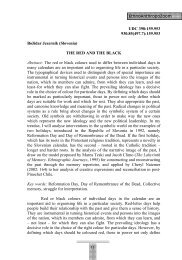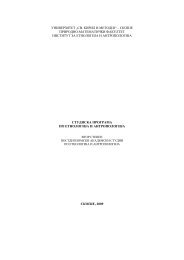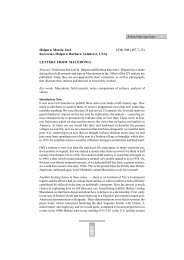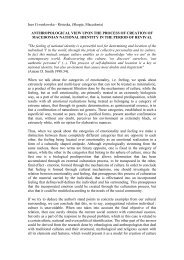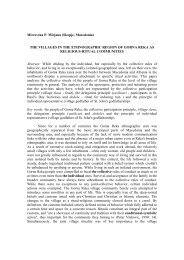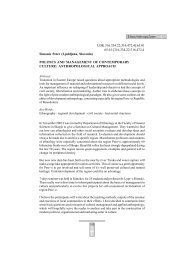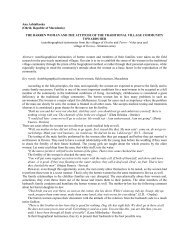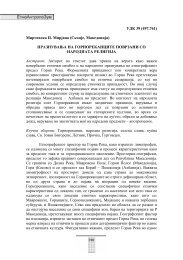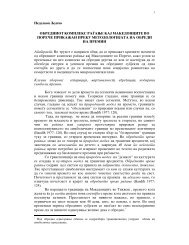Obrembski Jozef, Ritual and Social Structure in a Macedonian Village
Obrembski Jozef, Ritual and Social Structure in a Macedonian Village
Obrembski Jozef, Ritual and Social Structure in a Macedonian Village
Create successful ePaper yourself
Turn your PDF publications into a flip-book with our unique Google optimized e-Paper software.
sacred taboos. F<strong>in</strong>ally, <strong>in</strong> the organization <strong>and</strong> performance of household ritual she acts as the<br />
supreme authority, superced<strong>in</strong>g the position of the mascul<strong>in</strong>e family head, be it her husb<strong>and</strong> or son.<br />
Her ritual roles thus form an <strong>in</strong>tr<strong>in</strong>sic part of her elevated status.<br />
Women <strong>and</strong> the Cult of the Dead<br />
An important area of the ritual activities <strong>in</strong> which women aga<strong>in</strong> predom<strong>in</strong>ate are rites <strong>and</strong><br />
ceremonies associated with the cult of the dead. Men are not absent from these rites. But ritual<br />
roles assigned to women make female participation <strong>in</strong> mortuary <strong>and</strong> post-mortuary rites<br />
cont<strong>in</strong>uous, conspicuous <strong>and</strong> ritual ly expressive. Women are expected to mourn longer than men<br />
<strong>and</strong> the mourn<strong>in</strong>g observances with which they must comply, are more exact<strong>in</strong>g <strong>and</strong> severe. The<br />
performance of magic-religious practices associated with the death of a family member arid his<br />
burial is also part of their job. Their particular responsibility extends over the organization of postmortuary<br />
rites <strong>and</strong> tlie enactment Of ritual roles associated with commemoration of the deceased.<br />
They prepare the food for feasts on tliese occasions, distribute food <strong>and</strong> other gifts on the mourn<strong>in</strong>g<br />
days on behalf of the departed, make ritual offer<strong>in</strong>gs of food, fruits, br<strong>and</strong>y <strong>and</strong> flowers at tlie<br />
grave, <strong>and</strong> participate <strong>in</strong> ritual lament<strong>in</strong>g <strong>and</strong> wail<strong>in</strong>g sometimes for as many as three years alter a<br />
burial.<br />
(14) Wail<strong>in</strong>g is one of the central <strong>and</strong> most demonstratively conspicuous ritual acts of private<br />
family rites as well as at communally organized commemorations of the dead by the whole village,<br />
on "dead Saturdays" or <strong>in</strong> connection with the more important holy days. On these occasions men<br />
may st<strong>and</strong> close to their family graves, they may express grief by weep<strong>in</strong>g or cry<strong>in</strong>g aloud, or they<br />
may engage <strong>in</strong> talks with others, exalt<strong>in</strong>g the virtues or deplor<strong>in</strong>g the suffer<strong>in</strong>gs of their deceased<br />
family members. But the ritual expression of family sentiments <strong>and</strong> of a sense of unity between the<br />
liv<strong>in</strong>g <strong>and</strong> the dead is tlie role of women.<br />
The allocation of these roles stresses the bilateral basts of the family <strong>and</strong> k<strong>in</strong>ship ties. A woman is<br />
obliged to lament for the members of her family of orientation, her family of procreation, <strong>and</strong> the<br />
jo<strong>in</strong>t family she entered on marriage. She is expected to wail for different periods of time for her<br />
mother <strong>and</strong> her father, lie r child, her husb<strong>and</strong>, her brother <strong>and</strong> sister <strong>and</strong> her cous<strong>in</strong>s <strong>and</strong> for her<br />
various <strong>in</strong>-laws.<br />
The Medic<strong>in</strong>e Woman <strong>and</strong> the Holy Woman<br />
The equalization of the status of women with positions held by men through the allocation of<br />
important ritual responsibilities is particularly conspicuous with respect to heal<strong>in</strong>g magic. This is an<br />
area monopolized almost exclusively by women. Heal<strong>in</strong>g magic is effective only when performed<br />
by older women past child-bear<strong>in</strong>g age. It consists of a large collection of separate magical<br />
performances, each <strong>in</strong>clud<strong>in</strong>g manual acts <strong>and</strong> elaborate spells, the exact knowledge of which is<br />
<strong>in</strong>dispensable for the (15) practice' ol the profession. To be fully effective, the spells must be<br />
transmitled <strong>in</strong> the performer's mother's l<strong>in</strong>e, "from my faith <strong>and</strong> from by blood."<br />
Every old woman <strong>in</strong> the village knows <strong>and</strong> practices some heal<strong>in</strong>g magic. To atta<strong>in</strong> a status of<br />
prava basnaritsa, true medic<strong>in</strong>e-woman, a woman has to have expert knowledge of a whole<br />
collection of rites <strong>and</strong> spells appropriate for various ailments, <strong>and</strong> she has to own the paraphernalia<br />
ol her art. <strong>in</strong>clud<strong>in</strong>g a consevreated deer's horn, with which she exorcises all k<strong>in</strong>ds of evils, <strong>and</strong><br />
f<strong>in</strong>ally, she has to establish a reputation as an effective healer. She has to be able to properly<br />
diagnose the ailment, whether it is from God, evil spirits or witchcraft, <strong>and</strong> apply appropriate ritual,<br />
<strong>in</strong>clud<strong>in</strong>g counter-magic, by which the black magic is destroyed <strong>and</strong> its perpetrator eventually



